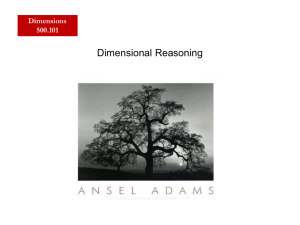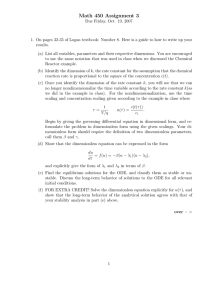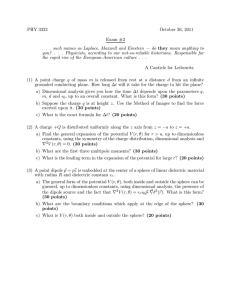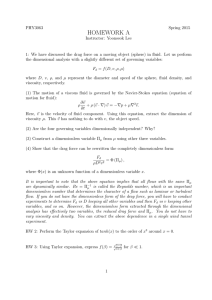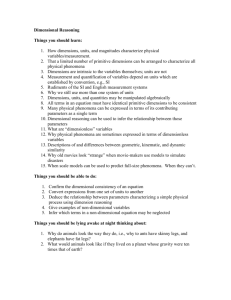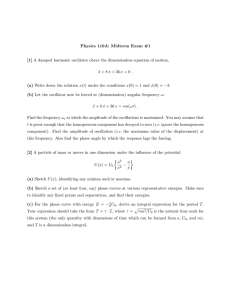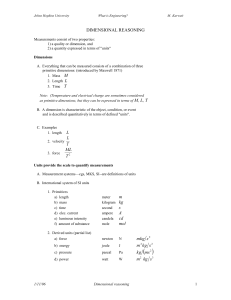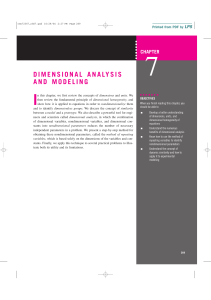Dimensional Analysis & Similarity
advertisement
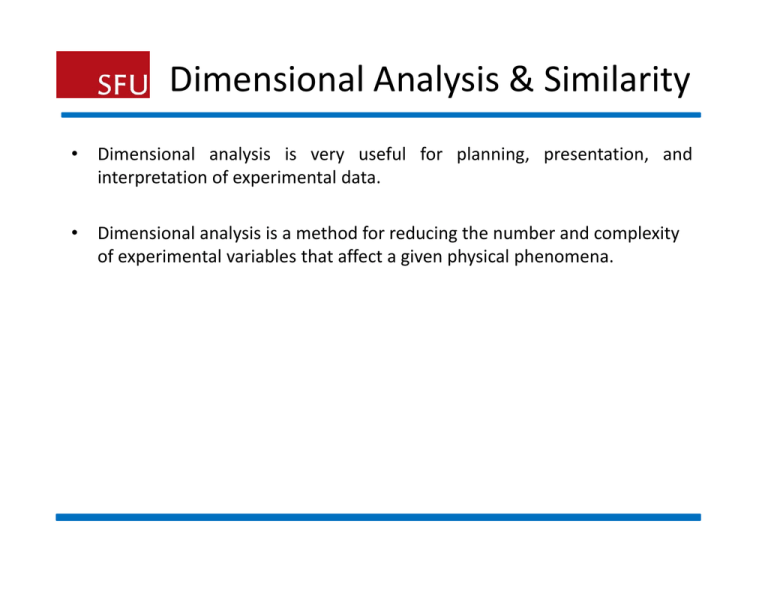
Dimensional Analysis & Similarity
•
Dimensional analysis is very useful for planning, presentation, and
interpretation
p
of experimental
p
data.
•
Dimensional analysis is a method for reducing the number and complexity of experimental variables that affect a given physical phenomena
of experimental variables that affect a given physical phenomena. Dimensional Analysis
•
Reduce the number of variables: Suppose the force F on a particular body shape immersed in a stream of fluid depends only on the body length L, velocity V fluid density and viscosity μ:
velocity V, fluid density and viscosity μ:
• Using dimensional analysis, we can reduce the parameters to only one:
• Non‐dimensional equations: that will provide insight on controlling parameters and the nature of the problem.
• Scaling laws: that allows testing models instead of expensive large full‐scale S li l
h
ll
i
d l i
d f
i l
f ll
l
prototypes. Dimensional homogeneity
•
In a dimensionally homogenous relationship for a physical process, each term will have the same dimensions. •
For example in the Bernoulli equation, each term, including the constant, has dimensions of velocity squared [L2T‐2].
Variables and scaling parameters
•
The variables are the things we wish to plot, the basic output of the
experiment or theory. The parameters are those quantities whose effects
on the variables we wish to know.
•
For example, consider the relation that expresses the displacement of a falling body Variables (S t) and parameters (S0, V
falling body. Variables (S, t) and parameters (S
V0, g)
g)
TTo non‐dimensionalize our results, we need to know how many dimensions di
i
li
l
d k
h
di
i
are contained among our variables (S, t) and parameters (V0 , S0, and g); in this case only two, length {L} and time {T}:
{S} = {S0} = {L} {t} = {T} {V0} = {LT‐1} {g} = {LT‐2}
• We select any two of the three parameters to be scaling parameters, thus we h
have three choices:
th
h i
Option 1: S0 and V0 (effect of g) •
Using these scaling parameters, we define non‐dimensional displacement and time as:
• Substituting these variables into the falling‐body equation, after simplifications:
Option 2: V0 and g (effect of S0)
•
The non‐dimensional parameters will be:
• Substituting these variables into the falling‐body equation, after simplifications:
Option 3: S0 and g (effect of V0)
•
The non‐dimensional parameters will be:
• Substituting these variables into the falling‐body equation, after simplifications:
Selection of scaling parameters
•
In all three options, the same parameters α appears but has a different meaning: dimensionless gravity, initial displacement, and initial velocity.
Guidelines:
The scaling variables must not form a dimensionless group among themselves, g
g p
g
but adding one more variable will form a dimensionless quantity. For example, in the above fluid flow problem, test the powers of Do not select output variables for your scaling parameters.
If convenient, select popular, not obscure, scaling variables because they will appear in all of your dimensionless groups.
The Pi theorem
•
The Buckingham theorem provides a method for computing sets of
dimensionless parameters from the given variables, even if the form of the
equation is still unknown.
unknown
• Let
be n dimensional variables that are physically relevant in a
given problem and that are inter‐related by an (unknown) dimensionally
homogeneous set of equations.
• If k is
i the
h number
b off fundamental
f d
l dimensions
di
i
required
i d to describe
d
ib the
h n
variables, then there will be k primary variables and the remaining j = k – n
variables can be expressed as n – k dimensionless and independent quantities
or ‘Pi
Pi groups
groups’
• Note: this set of non‐dimensional parameters is not unique. They are
however independent and form a complete set.
Applying Pi theorem
1) Clearly define the problem and think about which variables are important.
Identify which is the main variable of interest
It is
i important
i
t t to
t physically
h i ll think
thi k about
b t the
th problem.
bl
A there
Are
th
any
constrains, i.e. can I vary all these variables independently?
2) Express each of n variables in terms of its fundamental dimensions,
dimensions {MLTθ}
or {FLTθ}. It is often useful to use one system to solve the problem, and then
check that groups you obtain are dimensionless by converting to other system.
3) Determine the number of Pi groups, j = n – k variables, where k is the
number of reference dimensions and select k primary or repeating variables.
Typically pick variables which characterize the fluid properties, flow geometry,
flow rate…
4) Form j dimensionless Π groups and check that they are all indeed
dimensionless.
Applying Pi theorem
5) Express result in form
where contains the quantity of
interest and interpret your result physically!
6) Make sure that your groups are indeed independent; i.e. can I vary one and keep others constant?
7) Compare with experimental data!
Dimensionless basic equations
•
•
Another useful application of pi theorem is application to the basic
(governing) equations.
E
Even
th
though
h these
th
equations
ti
cannott be
b solved
l d in
i general,l they
th will
ill reveall
basic dimensionless parameters, such as Reynolds number, in their proper
form and proper position, giving clues when they are negligible.
• These equations contain the three basic dimensions M, L, and T. All variables
p, V, x ,y ,z, and t can be non‐dimensionalized by using density and two
reference
f
constants
t t that
th t might
i ht be
b characteristic
h
t i ti off the
th particular
ti l fluid
fl id flow:
fl
Reference velocity = U
Reference length (or characteristics length) = L
Dimensionless basic equations
•
•
As an example, U can be the inlet or upstream velocity and L the diameter of
a body immersed in the stream. We can define all dimensionless variables:
After substitution and simplifications, we obtain:
Non‐dimensional Parameters
The continuity equation contains no parameter; however, the momentum
(Navier‐Stokes) equation reveals the Reynolds number:
Euler number (pressure coefficient) is rarely important unless the pressure
drops low enough to cause vapor formation (cavitation) in a liquid:
Froude number is the dominant effect in free‐surface flows and it does not
appear if there is no free surface:
Mach number has a strong effect on compressible flow properties if it is
greater than 0.3:
Modeling and its pitfalls
Performing scale analysis is mathematically straightforward; however, there are several issues to consider:
1) We took for granted the important variables for the phenomena. Selection of
important variables is not a trivial task and requires considerable judgment and
experience.
2) Typically the Reynolds number of the model is too small (by a factor of 10 to
1000). As a result, we end up estimating the desired high‐Reynolds‐number
prototype data, by extrapolating the model data in low Re. This may result in
high uncertainty in the analysis; but there is no other practical alternative in
hydraulic model testing.
Model vs. prototype
Typically the Reynolds number of the model is too small (by a factor of 10 to 1000. Modeling and its pitfalls cont’d.
3) After selecting important parameters and determining pi groups, we should
seek to achieve similarityy between the model tested and the p
prototype
yp to be
designed. In general:
“Flow conditions for a model test are completely similar if all relevant
dimensionless parameters have the same corresponding values for the model and
the prototype.”
Establishing
bli hi complete
l
similarity
i il i is
i highly
hi hl unlikely.
lik l Therefore,
h f
we seekk particular
i l
types of similarity.
Geometric similarity
Geometrical similarity is established when:
A model and prototype are geometrically similar if and only if all body dimensions A
model and prototype are geometrically similar if and only if all body dimensions
in all 3 coordinates have the same linear scale ratio.
Kinematic similarity
It requires that the model and prototype have the same length scale ratio and
the same time scale ratio; thus the velocity scale ratio will be the same for both.
Length scale equivalence simply implies geometric similarity, but time scale
equivalence may require additional dynamic considerations such as equivalence
of the Reynolds and Mach numbers.
Dynamic similarity
Dynamic similarity exists when the model and the prototype have the same
length scale ratio, time scale ratio, and the force scale (mass scale) ratio.
Dynamic similarity exists, simultaneously with kinematic similarity, if the model
and prototype force and pressure coefficients are identical. This is established if:
1) For compressible flow, the model and prototype Reynolds number and Mach number and specific heat ratio are correspondingly equal.
2) FFor incompressible flow:
i
ibl fl
a) With no free surface: model and prototype Reynolds numbers are equal.
b) With a free surface: model and prototype Reynolds number,
number Froude
number, and (if necessary) Weber number and cavitation number are
correspondingly equal.
Dynamic similarity


